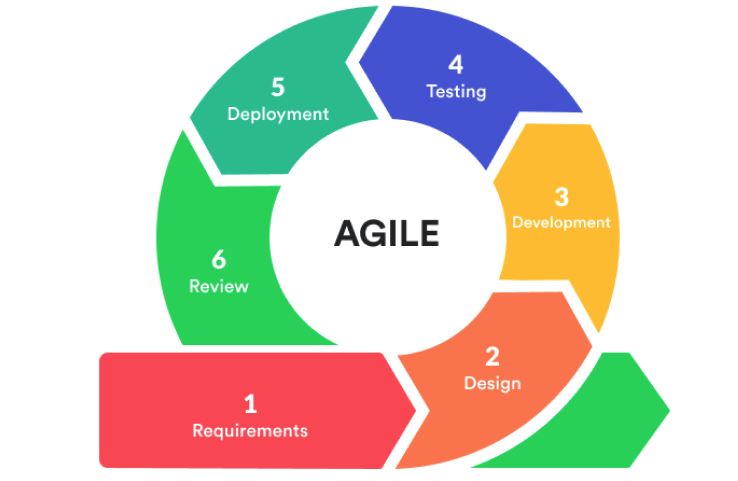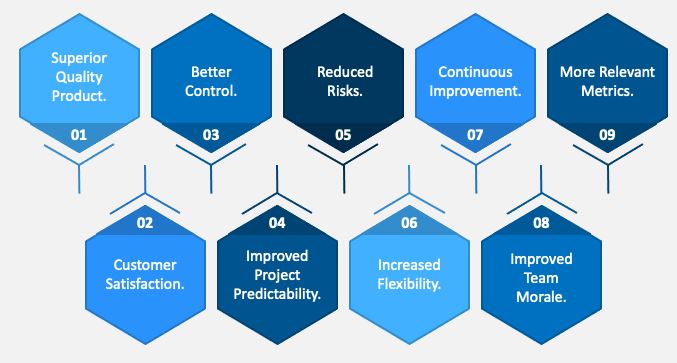
What is Agile |Its Methodology and Types | How to Implement [ OverView ]
Last updated on 05th Nov 2022, Artciles, Blog
- In this article you will learn:
- 1.What is Agile?
- 2.Agile Methodologies.
- 3.Agile Principles.
- 4.Advantages of Agile.
- 5.Agile Disadvantages.
- 6.Requirement Gathering and Analysis.
- 7.Using Agile and Waterfall Methodologies.
- 8.Conclusion.
What is Agile?
Agile is the iterative way of managing projects and developing a software that makes it easier for teams to deliver value to the customers more quickly and effectively. An agile team is to deliver a small but consumable increments of work rather than a wagering everything on a big bang launch.
Agile Methodologies:
1. Extreme Programming:
It is the framework that enables teams to create a high-quality software that helps improve their quality of life. It enables a software development alongside appropriate engineering practices. It is applicable for while handling changing the software requirements risks caused due to new software, working with the small, extended development team and technology that allows automated unit and functional tests.
2. Kanban:
It is the method that’s used to design, manage, and improve flow of a systems. Kanban enables organizations to visualize their flow of a work and limit the amount of work in a progress. It is used in situations where a work arrives unpredictably, and where it needs to be a deployed immediately without waiting for the other work items.
3. Lean:
It is the set of tools and principles that focuses on an identifying and removing waste to speed up a process development. Value is maximized and waste is minimized. It is used in a just about every industry that produces a waste in some form.
4. Scrum:
It is the framework used by teams to establish a hypothesis, test it, reflect on a experience, and make adjustments. It enables a teams to incorporate practices from the other frameworks depending on requirements. It is used by a cross-functional teams that are working on a product development, and the work is split into the more than one 2-4 week iterations.
5. Crystal:
It focuses on a people and their interactions, rather than on a tools and processes. Aimed to be streamline processes and improve optimization, Crystal works on a principle that projects are unique and dynamic. It is used when a focus is on strengthening team communication, continuous integration, active user involvement and also configurable processes.

Agile Principles:
To make process Agile following principles need to be a satisfied.
1. Customer Satisfaction:Customer needs to be a satisfied with a quick delivery of the product.
2. Welcome Change:Even late in a development process, changing needs need to be an addressed.
3. Deliver Frequently:Focus on the shorter timescale, and ensure products are be delivered frequently.
4. Work Together:Business and development team need to be work together through a course of the project.
5. Motivated Team:Team members must be a motivated and trusted to complete a project successfully and on time.
6. Face-to-face:Having a face-to-face interactions is one of the most effective forms of the communication.
7. Working Software:Having working output is the indication of a progress made towards a final product.
8. Constant Pace:Agile promotes a sustainable development.
9. Good Design:Improve an agility by focusing on a good design and technical excellence.
10. Simplicity:The amount of a time where work isn’t being done needs to be a reduced.
11. Self-Organization:These types of a teams provide best designs, requirements and architectures.
12. Reflect and Adjust:The effectiveness of a team can be improved by regularly reflecting on a work and making improvements.
Advantages of Agile:
- Agile enables the large amount of collaboration and interaction between a client and the project team.
- Thanks to this clients have an improved transparency and therefore clearer understanding of a phases of the project is present.
- The product is be delivered predictably or sometimes earlier than an expected.
- The cost of a project is predictable and follows the rigid schedule.
- Changes can refine and also re-prioritize a product backlog.
- Enables a client to prioritize different features allowing team to ensure a maximum project value.
- The project is broken down into the smaller units, providing a high-quality development, testing and collaboration.

Agile Disadvantages:
- An Organizational cultures can conflict with an agile values.
- Teams may use the inconsistent practices.
- Teams may encounter a resistance from organizations to change in an adoption.
Requirement Gathering and Analysis:
All system requirements that need to be developed are collected in a phase and documented in the requirement specification document:
System Design:
The requirements froma previous phase are studied, and the system design is set up. The system design helps to specify a hardware and the system requirements. It also helps to explain the system’s architecture.
Implementation:
Based on a system design, small programs called units are developed. These units are integrated into a next phase of the process. Each of these units is developed and tested for a functionality; this process is called a Unit Testing.
Integration and Testing:
After every unit is tested, it is integrated into the system. After this, the entire system is checked for a faults and failures.
Deployment of System:
Once functional and non-functional testing is be completed, the customer environment is given access or released into a market.
Maintenance:
To handle problems that come up in a client environment, patches are released. Maintenance can also help to enhancea project. Maintenance can help with a delivering changes to a customer environment.
Using Agile and Waterfall Methodologies:
Not all the projects neatly fall into one of a two categories. An Agile-Waterfall hybrid approach can make a sense for projects that could benefit from aspects of both the traditional approach and an iterative approach. It could can imply, for instance, that planning and design get a done using the Waterfall method while a development is by Agile’s short development cycles.
Conclusion:
Agile methodologies enable an organizations to deliver value to customers faster and with a fewer complications by systematically managing projects and developing software in the iterative fashion. The approach of an agile team is to deliver a work in small, but consumable, increments, rather than wagering everything on “big bang” launch. As a result of a continuously evaluating requirements, plans and results teams are able to respond to change in the timely manner.
Are you looking training with Right Jobs?
Contact Us- How To Run An Effective Agile Retrospective-Agile management | Everything You Need to Know
- Top 10 Tips for Agile Sprint Planning To Implement Efficient Marketing | Step-By-Step Process with REAL-TIME Examples
- What is Scaled Agile Framework (SAFe) | The Leading Framework For Business Agility | Everything You Need to Know
- Scrum vs Kanban | Agile at Scale | New Agile BenchMark
- What is Agile |Its Methodology and Types | How to Implement [ OverView ]
Related Articles
Popular Courses
- Hadoop Developer Training
11025 Learners - Apache Spark With Scala Training
12022 Learners - Apache Storm Training
11141 Learners
- What is Dimension Reduction? | Know the techniques
- Difference between Data Lake vs Data Warehouse: A Complete Guide For Beginners with Best Practices
- What is Dimension Reduction? | Know the techniques
- What does the Yield keyword do and How to use Yield in python ? [ OverView ]
- Agile Sprint Planning | Everything You Need to Know
